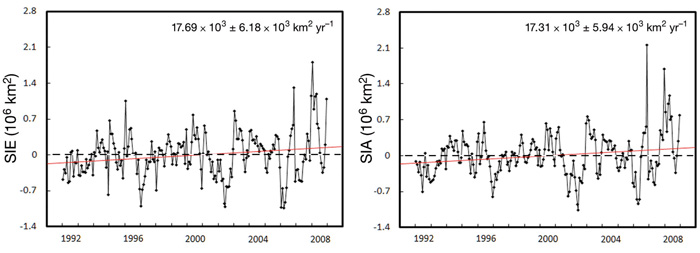| Follow @co2science |
Paper Reviewed
He, L.Y., Ke., C.Q., Zhou, X., Cui, Y.N. and Shan, L. 2016. Antarctic sea ice change based on a new sea ice dataset from 1992 to 2008. Climate Research 71: 155-169.
Writing as background for their work, He et al. (2016) note that sea ice is "an important component of the global climate system," where its presence on the ocean surface "increases surface albedo (Zhou et al., 2007), insulates ocean water from heat loss or gain, and provides a barrier to the exchange of momentum (e.g. wind) and mass (e.g. water vapor and CO2) between the ocean and atmosphere." Its presence (or absence) can therefore exert a marked influence on regional atmospheric and oceanic circulation, ultimately impacting global climate. Given such importance, trends in sea ice have been closely monitored over the past few decades by scientists looking for evidence of change as predicted by climate models, which models foresee a large-scale diminishing of ice in Earth's polar regions in response to CO2-induced global warming.
The latest group to perform such an analysis is the five-member research team of He et al., who employed a new mathematical algorithm to convert observed satellite-derived microwave brightness temperatures into a new sea ice concentration dataset for the Antarctic. Thereafter, they performed a spatiotemporal analysis of the data to investigate changes and trends in Antarctic sea ice extent and area over the period 1992 to 2008. And what did that analysis reveal?
Although there were regional differences, He et al. report that both sea ice extent and sea ice area increased over the period of analysis at rates of 17.7 x 103 km2 yr-1 and 17.3 x 103 km2 yr-1 (see figure below), respectively, which finding, we note, is opposite model projections of overall diminished sea ice in the Antarctic in recent years due to global warming. Such findings confirm the previously published calculations of Parkinson and Cavalieri (2012), Reid et al. (2013, 2015) and Simonds (2015), all of which studies confirm an overall increase in sea ice for the Southern Ocean in recent decades. Consequently, it would appear that when it comes to predicting sea ice in the Antarctic, the models could use a tune-up, if not a major overhaul. Or, perhaps all that is needed is a climate alarmist to come along and torture the data long enough to get it to confess the proper (i.e, the model projections) result!

Figure 1. Monthly deviations of sea ice extent (SIE) and sea ice area (SIA), respectively, for the Southern Ocean surrounding Antarctica over the period 1992-2008.
References
Reid, P., Stammerjohn, S., Massom, R., Scambos, T. and Lieser, J. 2015. The record 2013 Southern Hemisphere sea-ice extent maximum. Annals of Glaciology 56: 99-106.
Reid, P.A., Tully, M.B., Klekociuk, A.R., Krummel, P.B. and Rhodes, S.K. 2013. Seasonal climate summary Southern Hemisphere (spring 2012): Warmer and drier across much of Australia, along with a new Southern Hemisphere sea ice extent record. Australian Meteorological and Oceanographic Journal 63: 427-442.
Simmonds, I. 2015. Comparing and contrasting the behavior of Arctic and Antarctic sea ice over the 35 year period 1979-2013. Annals of Glaciology 56: 18-28.
Zhou, X., Li, S., Morris, K. and Jeffries, M.O. 2007. Albedo of summer snow on sea ice, Ross Sea, Antarctica. Journal of Geophysical Research 112: D16105.
Posted 2 May 2017



